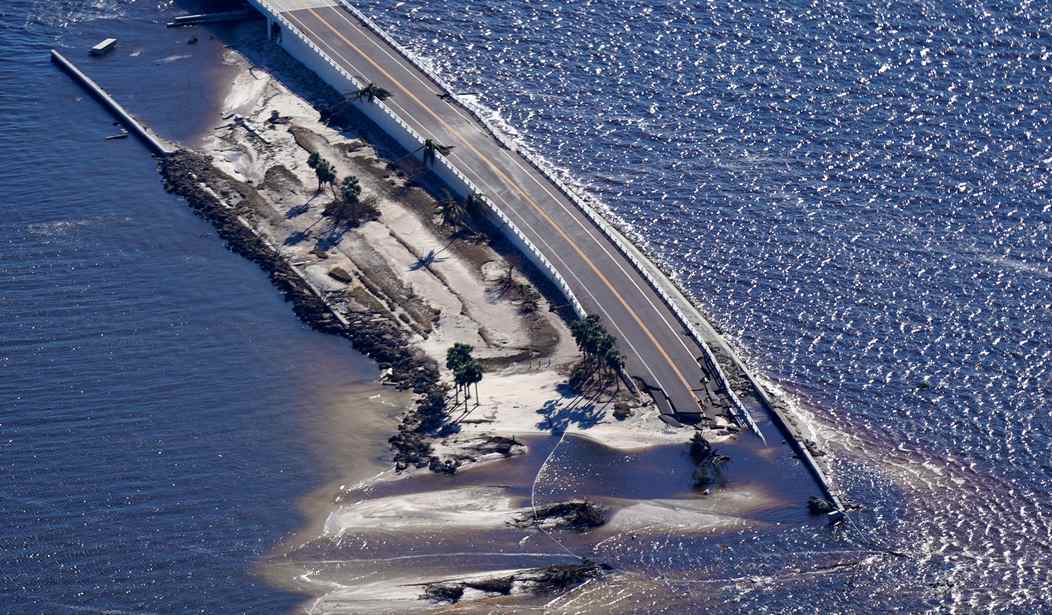I had a hunch, as the day wore on, that another fine opportunity to set the record straight was being offered in an AP news item posted at Newsmax, following the arrival of Hurricane Nicole on Florida's East Coast. I was not wrong.
The AP was once again caught attempting to attribute the cause of severe weather events to man-made climate change.
Nothing of the sort. Detailed analyses of time series going back a century reveal no significant trends in either frequency of land-falling hurricanes or their severity in the US record, as charted by NOAA and its predecessors.
The most recent hurricane to make land-fall on US shores was Hurricane Nicole arriving (as the eye) at Vero Beach, Florida, on November 9, 2022.
The sprawling storm that inflicted most of its damage as shoreline erosion farther to the north of Vero in Brevard and Volusia Counties (the popular beach communities around Daytona Beach). The late-forming tropical storm took its time gathering strength over the Bahamas before moving ever slowly west toward Florida.
Ten days after Nicole had come and gone, I had occasion to visit the area of maximum shoreline damage—inflicted by the high-tide surf and wave action directed against exposed sections south of Daytona Beach.
Strong onshore winds (at times reaching hurricane strength) pushed abnormally high tides against the beach communities. Scientists call the process ocean “set up.” Sustained winds from a single, preferred direction will drive up sea level (temporarily), and if timed with the arrival of a high tide, assist the breaking surf to reach well up onto bordering dunes, back beach and structures, vastly enhancing potential for damage via erosion.
Recommended
The tidal crest also arrived at just the time of a king tide, itself the result of the moon approaching closer to Earth than normal.
The setting along Florida’s Highway A1A that runs atop the dunes through Port Orange and continues as a county road south to Wilbur-on-the-sea found itself in direct line to take the brunt of the wave damage from Nicole.
Several dozen homes and cottages that face the beach sustained damage, moderate to severe, as the breakers piled up and overran the beach front. Already depleted of its beach sand from the effects of Hurricane Ian a month earlier, the breakers had unimpeded access to the houses in their path. Break-waters and other structures previously present to mitigate against damage were rendered useless to prevent rapid erosion of dune sand from beneath the decks that extended out toward the beach.
I stopped to discuss rehabilitation of shore houses underway at one of the locations at Wilbur. Three nephews had come from Ohio to assist their aunt in patching up the exposed ocean-facing side of her house. The deck was gone. A sheer drop of some 40 feet extended from the back of the house down to the level of the “new” beach.
The party informed me that the town board was expected to rescithe condemnation of the certificate of occupancy for their aunt’s dwelling. Similarly, repairs to other damaged houses were underway along the strand.
I observed several gaps in an otherwise continual line of beach houses on the ocean side of the highway. Most other houses superficially appeared intact and undamaged as viewed from the vantage point of the highway. But I was informed that many had lost their decks.
The recent episode near Daytona Beach also recalls autumn storm seasons farther up the Atlantic coast on the northern Outer Banks of North Caroline. Late autumn is the common time for what can be devastating nor’easters starting from the Mid-Atlantic States up through New England and the Canadian Maritimes.
Had Niclole formed a few hundred miles farther north it would have been designated an extra-tropical storm. And if it had also formed within a hundred miles of the US coastline, it would have been recorded among the countless nor’easters of centuries past.
These storms most often tend to move deliberately up along the coast, often centered just offshore onto the Atlantic. If they should stall, as sometimes they will, they may drive heavy rain and snow, along with gale-force winds from the Outer Banks farther to the northeast.
A nor’easter is capable of inflicting severe shore erosion along exposed stretches of coastline such as the northern Outer Banks.
From a few decades ago, I recall driving along what was then the shore road that coursed southward from Kitty Hawk, Kill Devil Hills and Nagshead, NC. Less than a decade afterward, much of the roadway, with dozens of houses on both the seaward and landward sides, was eroded away by the sea and no longer exists.
A sustained period of three or four days of constant pounding by heavy surf whipped up by 40- to 50- mph winds will mercilessly destroy the dunes in its path.
The reality is that a nor’easter can be more damaging to shore property than an average-strength hurricane that comes ashore and leaves the area within a few hours.
Nicole behaved, in this respect, much more like a nor’easter than a typical tropical storm.
Now the Northeast awaits the arrival of what could turn out to be the strongest nor'easter in more than a decade.
William D. Balgord, Ph.D. (geochemistry) heads Environmental & Resources Technology, Inc. in Middleton, WI and Fort Pierce, FL.

























Join the conversation as a VIP Member